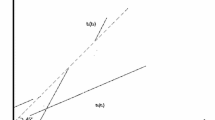Abstract.
This paper presents a two-country migration model, following Galor (1986), in which the world population consists of two types individuals. Individuals with a high (low) degree of altruism give to their children a high (low) level of bequest. Production uses three inputs: immobile land, mobile labour, and capital. Capital mobility is linked to labour mobility since individuals move with their inheritance. The model shows that countries are homothetic in the post-migration equilibrium with equal factor prices and equal densities of population. Migration flows are bilateral and the number of each type of migrants is uniquely determined. In some cases, migration leads to a Pareto improvement in both countries.
Similar content being viewed by others
Author information
Authors and Affiliations
Additional information
Received: 8 July 1999/Accepted: 7 April 2000
Rights and permissions
About this article
Cite this article
Gaumont, D., Mesnard, A. Inheritance, land, and capital mobility linked to labour mobility. J Popul Econ 14, 669–687 (2001). https://doi.org/10.1007/s001480000059
Issue Date:
DOI: https://doi.org/10.1007/s001480000059




